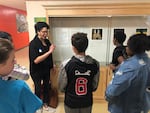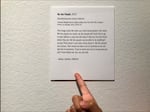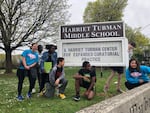Like most Black women, Lisa Jarrett had an emotional relationship with her hair growing up. “I think that it really became a marker of who I was in the world in certain ways. Even when I talk to my mom now, she’ll always ask, ‘How’s your hair?’ It’s a question that I expect to have to answer.”
As an art student in graduate school at the University of Montana in Missoula, Lisa began to explore and understand her own identity and relationship to media representations of black femininity and how that could eat away at how she saw herself. “I started to try to understand my relationship to blackness and the Black experience within the United States as a result of colonization and complex histories of slavery and enslavement, to kind of reel it back and try to understand my relationship to my own body and how it manifests for me and other Black women in the present day.”
Growing up she and her sister were often the only Black kids in their school or neighborhood and had ways of tending to their hair that were very different than the people around them. It was one of the ways in which difference first presented itself. For example, they always shopped for hair care products at a beauty supply store. You couldn’t buy products for Black hair at the regular grocery store.
“It’s not that I remember wanting my hair to look like white people’s hair,” Jarrett reflects. “But I do remember wanting the scents that white hair care products had. I wanted to pick something like Green Apple shampoo; I didn’t understand why my mom would say, ‘That’s not for our hair.’ And I would respond, ‘But it says for all hair types!’ She tried to reconcile that messaging – that what was being stated on the bottle was, in fact, not true for her.
Jarrett points out that even in supermarkets and drugstores today, it’s usually a seemingly segregated experience. “Often it’ll be called Ethnic Hair Care. There’s a way in which there are these cues and ways of where we are supposed to read where we can find things that are for us (Black people) as opposed to for everyone else, which is the normative, right? That’s the dominant, dominant identity of which I’m not a part of.”
That double meaning, the multiplicity of meanings and messages is something she explores and illuminates in her art. “What I’ve always liked across my practice are things that can mean at least two things at once. For example, in my project How Many Licks? I could employ degrees of access and degrees of refusal of access.”

In her studio-based practice, Lisa Jarrett creates objects, often related to and about the Black fem experience in relation to beauty and hair care.
Stephani Gordon / OPB
The project includes 156 lollipops installed in two panels on a gallery wall. They’re small sculptural objects made out of beet sugar at the center of which is a little bead of her hair set on a paper lollipop stick. “The sensation of hair in your mouth is a sort of immediate sensation we all kind of go to get rid of quickly. They’re physically edible but the imagined and real experience of hair in your mouth is not usually a pleasant one. But knowing that you could eat it is why it is edible as opposed to being a glass or a resin caste. I was interested in the attraction-repulsion tension that is inherent in the work.”
“I also like to obscure things. I like things that seem tough but are actually quite fragile. Things that seem fragile are actually very strong. And I like to play with materials, but I like to figure out what those materials are going to be. And I like to fuse and connect, things that haven’t always historically had a relationship with another, and the way that I would like them to have had. "
Jarrett is involved in many projects that take her out of her own studio practice and into collaborations with other artists and institutions. Art 25: Art in the Twenty-Fifth Century is a dynamic collective co-founded in 2019 by Jarrett and Lehua M. Taitano an interdisciplinary artist from Yigu, Guåhan (Guam).
Art 25 investigates Indigenous and Black art in the 21st century and collaborates with contemporary artists worldwide who envision how that art will flourish in the 25th century and beyond. It is the culmination of years (and ancestral lifetimes) of shared curiosity, vision, and an outright insistence to see their cultures thrive within contemporary art. In forming a future archive, the collective interrogates historical access, curation, collection, consumption, and preservation of Indigenous and Black art and culture.

Art 25: Art in the Twenty-Fifth Century's inaugural project "Future Ancestors" at Ori Gallery.
Stephani Gordon / OPB
Art 25′s inaugural project Future Ancestors, is a collaboration with artist Jocelyn Kapumealani Ng (Honolulu). “Together the three of us were questioning what it actively means to be an ancestor in the present, and thinking of who would be able to access you in the future,” she says. In this project, they try to embody their future descendants in the present tense, and document that experience as a sound piece with written words and photos with the help of photographer Bryan Kamaoli Kuwada.
Jarrett also works on multiple collaborative projects embedded in the Northeast Portland Metro community. This includes schools, studios, communities, museums, galleries and more. She is co-founder and co-director of KSMoCA, a contemporary art museum and social practice project inside Dr. Martin Luther King Jr. Elementary School. Founded in 2014 by Jarrett and artist Harrell Fletcher, who is also a Portland State University professor, KSMoCA connects public school students with internationally renowned contemporary artists through collaborative workshops, exhibitions, artist lectures and site-specific commissions. Students learn through experience about museum practice and careers in the arts by participating as curators, preparators, artists, gallerists, writers, and docents.

Lisa Jarrett and students engage in the Dr. Martin Luther King School Museum of Contemporary Art project.
KSMoCA
“We’ve essentially created a contemporary art museum inside the school for K through 5th grade. We bring artists in to work with students, have rotating exhibitions, one-on-one community mentorship programs, a selection of catalogs that showcases the work of our students, collaborating with the artists that are able to come in and work with us, a public lecture series, a young student curatorial committee, various commission projects from artists, both within our community and from a larger sort of national or international art world.”
KSMoCA reimagines the way museums, public schools, and universities can affect people, culture, and perspectives by sharing resources across organizations. The programs are developed collaboratively with the Dr. MLK Jr. School community, PSU students, and a team of supporting artists.
In 2018 Jarrett and Fletcher launched a satellite project to KSMoCA for kids moving on from the elementary school to Harriet Tubman Middle School, to work with kids over the course of their whole K-12 education. In this program, the student-participants learn about various curatorial approaches that include working with visual art, performance, public art, historical materials, social practice, as well as writing and critical assessment of contemporary art and culture.

'We the People' - Curatorial Writing for the Portland Art Museum.
KSMoCA
“Curators are really powerful people in what we see and experience and understand as art. And so we thought, wouldn’t it be interesting to have that partnership between kids and curation, where they’re making selections, they’re writing labels, they’re contributing and writing catalogs.”
The students apply their skills as a curatorial team working on projects at the middle school and various off-site locations. As part of the center’s activities, students meet with visiting curators and go on field trips to learn about local contemporary art institutions like the Portland Art Museum. She says, “so much of the way that our identities are formed is happening at the elementary and middle school ages and what you believe you have access to and how you see yourself really will direct so much of how you move throughout your life.”

Students from Harriet Tubman Middle School who are involved in the Expanded Curatorial Practice.
KSMoCA
“When you work with kids we have expectations of what they are capable of. But these kids have not been socially indoctrinated yet into thinking they need to sound or act in a certain way to be successful in this setting. They provide a perspective and insight that is much more honest than the conversations we tend to have in art spaces. And the questions they ask make me rethink the things that I expect in a curatorial experience. "
Through all the ways Jarrett expresses herself in her studio-based work, her collaborations, and her more socially engaged work, she believes uncertainty is part of the journey and her identity. “I don’t have much interest in doing something I know the outcome 100 percent. Doubt is how you know you are on the right track. Whatever that thing is you are trying to squirm out of or makes you feel like you don’t know how to do it yet, that doesn’t have to be paralyzing — that’s the moment you persist.”
But then there is the doubt of the current climate of 2020/2021. “Honestly, I’m questioning everything about the value of my work and what it means to me and the value of all these identities we’ve constructed for ourselves and how we want to navigate them. I’m really just at a moment of immense deep questioning. A lot is changing right now. And that raises a lot of other questions for me as an artist. But what I can say for the here and now, is making this kind of work really does anchor me. There’s so much more to learn there.”
If you wish to learn more about Dr. Martin Luther King School Museum of Contemporary Art (KSMoCA) and Harriet Tubman Center for Expanded Curatorial Practice, please go here: KSMoCA